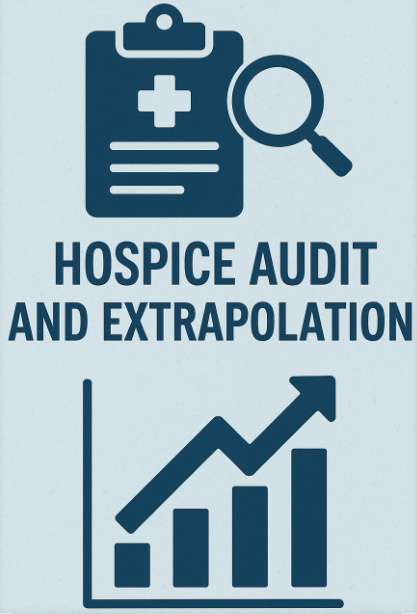Hospice agencies are under increasing scrutiny by government auditors. A particularly concerning and financially devastating aspect of government audits is the use of statistical extrapolation. Understanding the extrapolation process is essential for providers to safeguard the financial healthof their agencies and ensure compliance with all regulations.
What is Government Extrapolation in Hospice Audits?
Extrapolation is a statistical methodology used by auditors, particularly the Office of Inspector General (OIG). Extrapolation can significantly amplify the financial implications of audit findings. The process of extrapolation is governed by the Medicare Program Integrity Manual, Chapter 8. This chapter of the manual outlines the specific statistical methods and requirements for conducting extrapolation studies.
What is Extrapolation?
Extrapolation is a sampling technique used to project audit findings from a small sample of claims to an entire population of claims. Instead of reviewing every single claim that a hospice has submitted for payment, auditors select a statistically valid sample for review. They then use the error rate found in the sample to estimate overpayments across all similar claims in the population. This allows auditors to perform a detailed review of only a small sample of claims while estimating the total amount of improper claims across a large population.
Auditing every single claim in the population is impractical due to time and resource constraints. By examining a representative sample, auditors can make statistically valid projections about a much larger group of claims without having to review each one individually.
How Does the Extrapolation Process Work?
The extrapolation process typically follows the following key phases:
- Universe Definition:
- Auditors define the “universe” or population of claims to be examined. This may be all Medicare hospice claims submitted by your agency within a specific period (e.g., all claims billed between January 1, 2024, and December 31, 2024) or a subset of claims (e.g., all General Inpatient Care claims).
- Sample Selection:
- Using statistical sampling software, auditors select a statistically valid random sample from the universe. The term “statistically valid” is significant because it ensures that the sample accurately represents the entire population. This allows for reliable projections from the sample to the larger group. The industry standard software used to support sample creation is called RAT STATS (created by the OIG for the U.S. Department of Health and Human Services). Typically, samples consist of 100 claims, though this can vary.
- Medical Review:
- Each claim in the sample is rigorously reviewed by independent medical contractors who determine whether the services provided met Medicare requirements for hospice eligibility and documentation. The auditors review the documentation for compliance with Medicare regulations, including patient eligibility, physician certifications, medical necessity for services, and appropriate billing for levels of care. Any claim found to be out of compliance is identified as an “error,” and the precise dollar amount of the overpayment for that specific claim is calculated.
- Calculation of Error Rate:
- A monetary error rate is determined for the sample. This is calculated by dividing the total dollar amount of improper payments found in the sample by the total dollar amount of payments for all claims in the sample.
- Extrapolating to the Universe/Statistical Projection:
- The calculated monetary error rate from the sample is applied to the entire “universe” of claims. This projects the estimated total overpayment across all claims in the defined audit scope. The estimated total overpayment is calculated as the monetary error rate of the sample multiplied by the total dollar paid for the audit universe.
How Does Extrapolation Impact a Hospice Agency?
Extrapolation can have a significant financial impact on hospice agencies. Even a small number of denied claims or identified overpayments in a sample can result in a large demand for repayment. This can pose a severe financial challenge. Further, responding to an extrapolated audit can pose a significant administrative burden on hospice agencies, requiring considerable time and resources from administrative and compliance teams.
Additionally, OIG audit findings are often publicly released. This raises concerns about agency reputational risk and may jeopardize relationships with referral sources and the community. An adverse extrapolated audit outcome can also lead to increased scrutiny in future audits and potentially trigger further investigative actions.
Mitigating Extrapolation Risk
Given these potential significant negative impacts of extrapolation, hospice agencies should consider proactive actions that could help mitigate the likelihood of negative audit findings. The most effective actions include:
- Robust Compliance Program: Agencies should implement and strictly adhere to a comprehensive compliance program. This includes continuous staff education on Medicare regulations, thorough patient eligibility assessments, diligent documentation of physician certifications, and accurate coding for all levels of care.
- Internal Auditing: Conduct regular, proactive internal audits of claims and medical records. Focus on high-risk areas identified by Medicare (e.g., General Inpatient Care (GIP) stays, long lengths of stay, live discharges). Identifying and correcting deficiencies internally before an external audit is crucial.
Looking Ahead
Government extrapolation in hospice audits represents a significant financial risk for hospice agencies. Understanding the statistical methodologies, maintaining excellent documentation practices, and implementing robust compliance programs are essential for surviving in this challenging regulatory environment.
Where Can You Find Out More
- OIG RAT-STATS Software – Free statistical sampling software
- Medicare Program Integrity Manual – Chapter 8 covers statistical sampling
- OIG Hospice Audit Reports – Recent audit findings and methodologies





0 Comments